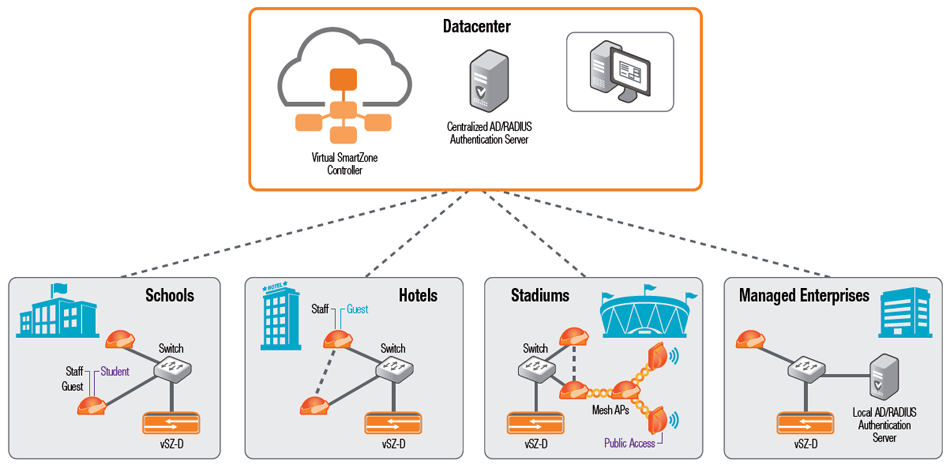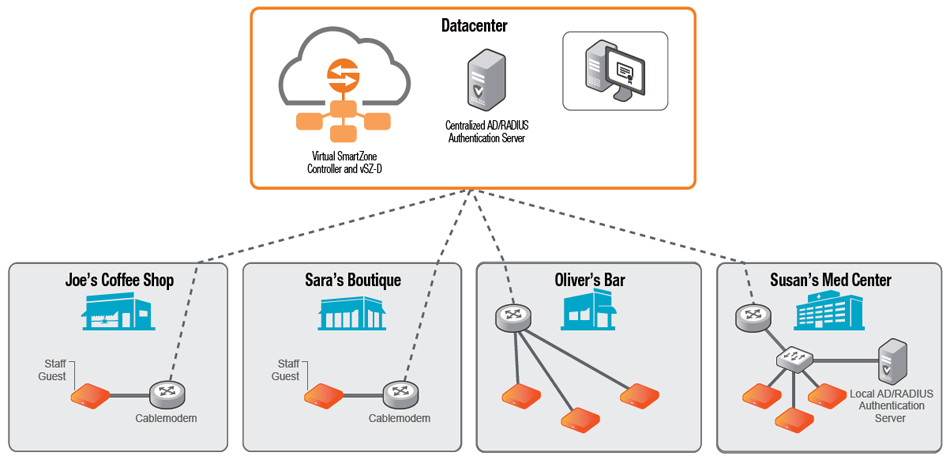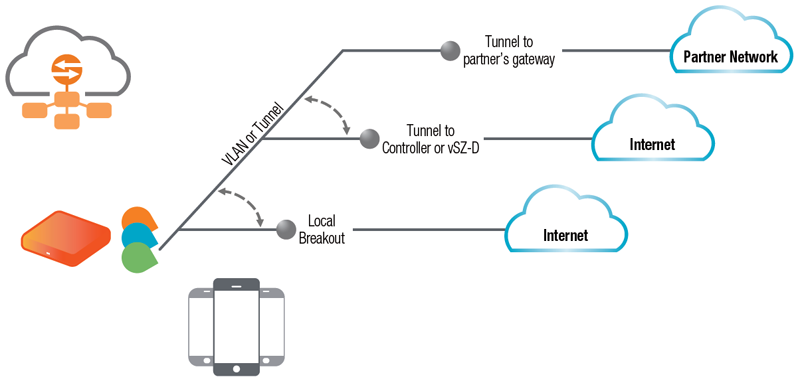
RUCKUS Virtual SmartZone – Data Plane (vSZ-D)
NFV-compliant WLAN Secure Data Plane Manager

מחירים נוספים מופיעים למטה, או לחצו כאן!
שימו לב: כל המחירים באתר כוללים מע"מ. החיוב יבוצע על פי שער "העברות והמחאות מכירה" של המטבע (דולר אמריקאי) ביום אישור ההזמנה.
Overview:
Enterprises and Service Providers must meet growing demands for how to more efficiently handle user data in distributed networks. Today's wireless customer expectations require delivering secure, high-performance, reliable and scalable WiFi services. The RUCKUS virtual SmartZone – Data Plane (vSZ-D) is a virtualized WLAN solution that assists to meet these demands.
Designed as a Network Functions Virtualization (NFV) application, vSZ-D can be easily deployed within an existing vSZ-E or vSZ-H network to provide secure and flexible user data plane management in either distributed or centralized configurations. This can address customer requirements to secure guest network Internet traffic, meet PCI compliance, and optimize VoIP quality by managing aggregates traffic through the secure tunnels. Leveraging the vSZ-D NFV architecture can also lower TCO/CAPEX costs and scales upwards to 10K APs and 100K clients per instance.
The RUCKUS Virtual SmartZone controller platform is the industry's most scalable Wi-Fi controller platform that enables service providers and enterprises to leverage virtualization technologies to deploy superior Wi-Fi management systems on standard x86 based systems. The Virtual SmartZone platform with its unique clustering architecture provides a scale-as-you grow model in the true sense by completely obviating the need for specialized hardware.
With the introduction of the Virtual SmartZone Data Plane (vSZ-D), RUCKUS launches an industry-first offering for sophisticated data plane capabilities in a virtualized form factor. The vSZ-D enables RUCKUS APs that are managed by a Virtual SmartZone controller to support WLANs that tunnel user data. The vSZ-D is built on Intel's DPDK1 framework and has been architected from the ground up to support aggregation of data from these tunnels (with encryption) at large scales with minimal data forwarding latencies. Designed for flexibility, the vSZ-D can be deployed in a centralized data center along with the network controller or can be deployed at specific venues in a distributed architecture while managed by a centralized controller. This architecture provides significant business and deployment benefits to mobile operators or enterprises.
vSZ-D can scale to handle tunneled data from upwards of 10K APs and 100K clients all managed by a single Virtual SmartZone controller instance to meet the requirements of the largest enterprise or service provider. The vSZ-D can be deployed in a private cloud to support one specific network deployment or in a public cloud that can support hundreds or even thousands of managed WLAN networks. vSZ-D instances can run on open-source KVM hypervisor or VMware vSphere hypervisor.
vSZ-D provides tremendous business value and architectural benefits in its ability to minimize CAPEX spending, minimize TCO and maximizing Wi-Fi deployment functionality. This approach is consistent with the industry trend toward Software Defined Networks (SDN) and ETSI Network Functions Virtualization (NFV) that segregates the control plane from the data plane.
Network Function Virtualization
Network Function Virtualization (NFV) is an extension of the basic computer virtualization. NFV takes this concept one-step further, adding design flexibility through segregation of major network functions and allowing them to operate in independent VM contexts.
Benefits:
Secure Tunneled WLANs
Enables forwarding of user data traffic through secure tunnels on RUCKUS APs when managed by Virtual SmartZone controllers
Flexible & Scalable Deployment Architectures
An industry-first support for centralized and distributed deployment architectures while enabling independent data plane and control/management plane scaling.
Depending upon the application and customer requirements, VM elements can be deployed distributed or centralized. vSZ-D aligns with the NFV concept, which results in a direct impact on CAPEX and TCO. RUCKUS has applied the NFV concept to the vSZ and vSZ-D design, which results in cost savings, increased service scalability, and multiple deployment options.
Deployment and Operational Simplicity
Works seamlessly with vSZ controllers, simplifying the need for Wi-Fi network management
Site Level QoS and Policy control
Service policy and QoS can be applied to the aggregated data flow on a site level rather than a per WLAN or AP, thus simplifying and optimizing policy decisions for Wi-Fi network operators.
Features:
Multiple Hypervisor Support
- Supports the most widely deployed VMware and KVM hypervisors
Dynamic Data Plane Scaling
- Supports 1Gbps, 10Gbps or even higher throughput capacities to support all types of enterprise and carrier deployments that can be dynamically tuned without needing software updates
Seamless Integration with vSZ Controller
- Simple integration and management with vSZ controller clustering architecture enables support for multiple vSZ-D instances
- 2 vSZ-D instances per vSZ instance
- 8 vSZ-D instances per vSZ cluster of 4 instances
- The vSZ controller runs in Active/Active (3+1) mode for extremely high availability. Each vSZ-D runs as an independent virtual machine instance that is managed by the vSZ controller
Superior Data Plane Functions
- Encrypted tunnel aggregation from all types of WLANs (Captive portal, 802.1x, HS2.0), VLANs, DHCP Relay, NAT traversal
Deployment:
Deployment Example - Distributed
Deploy vSZ-D on each site or venue for data plane aggregation and vSZ controller cluster in the data center for centralized management. Well suited for larger businesses high-density venues and multi-site enterprises.

Deployment Example - Centralized
Deploy vSZ-D alongside the vSZ controller in the data center for centralized data plane aggregation from all sites. Well suited for managed services providers targeting small and medium businesses.

RUCKUS APs managed by vSZ controllers provide service providers and enterprises with smart traffic redirection that is enhanced with the vSZ-D offering tremendous architecture flexibility that is unrivalled in the industry.

Specifications:
Minimum Hardware Recommendation
| Physical Characteristics | |
|---|---|
| Hypervisor Support | VMWare Esxi 5.5 and later OR KVM (CentOS 7.0 64bit) |
| Processor | Intel Xeon E5xx |
| Number of Cores | Minimum 3 cores per instance dedicated for Data plane processing. DirectIO mode for best data plane performance1. vSwitch mode for flexibility and service chaining. |
| Memory | Minimum 6 Gb memory per instance |
| HDD | Hard Disk 10 Gb per instance |
| NICs that support Intel DPDK |
|
1 Actual throughput numbers will vary depending on infrastructure and traffic type
Documentation:
Download the RUCKUS Virtual SmartZone - Data Plane Datasheet (PDF).
הערות תמחור:
- שימו לב: כל המחירים באתר כוללים מע"מ.
- החיוב יבוצע על פי שער "העברות והמחאות מכירה" של המטבע (דולר אמריקאי) ביום אישור ההזמנה.
- מחירי המוצרים וזמינותם כפופים לשינויים ללא הודעה מוקדמת.
המחיר שלנו: הצעת מחיר
המחיר שלנו: הצעת מחיר
המחיר שלנו: הצעת מחיר
המחיר שלנו: הצעת מחיר
המחיר שלנו: הצעת מחיר
המחיר שלנו: הצעת מחיר
המחיר שלנו: הצעת מחיר
המחיר שלנו: הצעת מחיר
המחיר שלנו: הצעת מחיר
המחיר שלנו: הצעת מחיר
המחיר שלנו: הצעת מחיר
המחיר שלנו: הצעת מחיר

